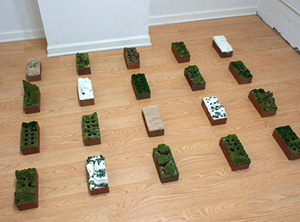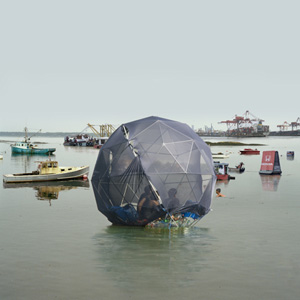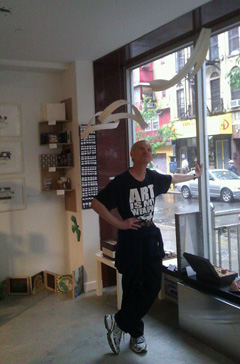The Climate for Art
John Haberin New York City
Steffani Jemison, Cullen Washington, Jr., and Jennifer Packer
Dionisio Gonzáles, Mary Mattingly, and Un/Natural Occurrences
Any artist would appreciate free studio space, especially if it will still be there tomorrow. Steffani Jemison may have had her doubts. At the Studio Museum in Harlem, she arrived one fall day to find the studio windows taped to withstand an approaching superstorm. Along with Cullen Washington, Jr., and Jennifer Packer, she might well have quit work and gone home.
"Expo 1: New York" brought a welcome summer reminder that the earth has a deep history, and so does earth art. Somehow, though, MoMA PS1 left out almost everything that matters to planet earth. What about art that confronts the headlines—and what of artists not yet headlines themselves? What about environmentalism based on science rather than spectacle? Where that exhibition offered a "dark optimism," what about a little less complacency and a little more light? What about artists able to withstand the storm? 
Art is capable of all those. Of the artists at the Studio Museum, none is overtly political, and only one sticks to her studio in the storm. Yet all three attend to what their exhibition calls "Things in Themselves." Meanwhile Dionisio Gonzáles and Mary Mattingly observe another environmental impact, waste. From Asia to Brooklyn, they experience garbage as a daily routine or even a home. As for a museum's omissions, "Un/Natural Occurrences" rectifies all those, with New York as its ecosystem.
Holding the fort
Of course, Steffani Jemison, Cullen Washington, Jr., and Jennifer Packer did survive, with new work to show for it at that, as three artists in the Studio Museum's annual program. (All three also appeared in "Fore," the museum's last show of emerging artists., as have two of three in a more recent residency, "Everything, Everyday.") Not everyone was so lucky, but then not everyone was on reasonably high ground halfway between the rivers, and not everyone has a museum's Buildings and Operations staff on hand. More than a few in Chelsea sustained damage, and many more elsewhere lost weeks of creative time. While other artists have referred to the event, no one else has come by the results so vividly and honestly. Jemison also leaves it, even after so many months, an unknown.
The very shape of the taping, an X on the glass, signifies an unknown. It also frames shifting views of the community. Being an artist, she could hardly help observing—and so she took out her camera and went to work. The prints on acetate, typically supported with gesso on panel, mime the translucency of the windows and the materials of the original black tape. Flatness, they say, like the formalists of the 1960s and 1970s, flatness, flatness, and flatness. Yet their depths are also filled with ghosts.
The ghosts include the shadows of the storm, raindrops on the windows, and the white stippling of an inkjet printer, all in sharply varying degrees of crispness. At one moment the X gets tangled up in parallel tape strips, almost like window blinds. At another it frames a water tower on a distant rooftop, like twin monuments to a mythical warrior. At still others, its shape multiplies into the crossed links of a chain-link fence. The fence, in turn, has a parallel in the work's tight, arbitrary framing. Like the fencing, the artist leaves open whether she is fencing things out or holding the fort within.
Washington does much the same with black and white. Visually, his collage amounts to a grid. Physically, it rips apart the canvas, sometimes extending beyond the confines of a rectangle. Used product logos provide a few additional elements, like "#1 Marquee," along with foil wrap and postal wrapping. A single color among the occasional high notes might become more dominant in another work. The museum sees a deliberative process. I see more a continued improvisation, a way of asking whether he, too, is fragmenting the scene in front of him or valiantly holding it together.
Packer's main subject is portraits of friends, and her main concern is giving them dignity and space. Her technique is wet on wet, with lots of brushwork in a narrow range of color. She claims inspiration from Jacob Lawrence and his Migration Series, Caravaggio, and practically the whole of art history. At most, I see an upside-down character out of Georg Baselitz and Baselitz drawings, some contorted masses out of late Michelangelo, loose green smears out of Neil Jenney, and maybe a touch of Lucien Freud. These huddling masses are yearning way too hard to breathe art. Put it down to the weather.
All three artists hint at a narrative. Jemison (also in a recent summer group show) has worked before with text in performance—and often in series as well. Most artists just settle for the freedom of studio space while they go about their business, although Willie Cole hit his stride while in the program in 1988 and 1989, in stumbling on an iron and seeing its potential for his art. Jemison got to start over, with a genuine unknown. She also directly observes her surroundings, in a country in which the African American community is so often an unknown. In a museum with a real origin in teaching, where studio artists are asked to receive visitors now and then, she pictures a community's fragile connections.
Global villages
If one wanted an emblem of globalization, beyond an assembly line in Colombia for Oscar Murillo or the shipping industry for James Benning and Peter Hutton, one could do worse than garbage. It lacks the glamour and anxiety of the Internet, rising economies, the bankruptcy of Detroit, or the sellout of the Detroit Institute of Arts. Yet it captures displaced peoples, poverty, pollution, consumerism, and the waste of human lives. Besides, it is easier to visualize, and it is something that everyone shares, like death. For their photographs, Dionisio Gonzáles and Mary Mattingly to the Third World, but digitally. With it, they picture a global village.
 Gonzáles also finds a hauntingly local one, in Ha Long Bay in Vietnam. Its limestone crags rise out of the waters with a covering of vegetation, shadows, and bird poop, but the only inhabitable islands are closer to the picture plane. There the inhabitants have built a shanty town of small boats from what those on land must have cast aside. Judging by the Vietnamese flags here and there, they take a certain pride in it. The Spanish photographer's horizontal format, mounted on plastic and metal, picks them out against the crisp blue skies and a misty depth. As with with Mary Mattingly in a dark natural world, one cannot write off something this forlorn, crowded, and picturesque as either an ideal or a ghetto.
Gonzáles also finds a hauntingly local one, in Ha Long Bay in Vietnam. Its limestone crags rise out of the waters with a covering of vegetation, shadows, and bird poop, but the only inhabitable islands are closer to the picture plane. There the inhabitants have built a shanty town of small boats from what those on land must have cast aside. Judging by the Vietnamese flags here and there, they take a certain pride in it. The Spanish photographer's horizontal format, mounted on plastic and metal, picks them out against the crisp blue skies and a misty depth. As with with Mary Mattingly in a dark natural world, one cannot write off something this forlorn, crowded, and picturesque as either an ideal or a ghetto.
Borrowing (or recycling) from Michel Foucault, Gonzáles calls it a heterotopia—or a "physical localization of the utopia." And his panoramas mix Cubist geometries among the makeshift huts. Here he leans on Le Corbusier, whose own ideal cities suffered from poor construction and isolation from the vitality of city streets. Gonzáles draws his on the computer, before inserting them into the landscape. The unnatural village, though, is sadly real. When he speaks of a "concrete space that inhabits the imaginary spaces of illusion or of perfection," he is right only about the imaginary and the concrete.
Mattingly is harder still to pin down. She composes her garbage heaps in Brooklyn, without benefit of the computer, before embedding them in her floating islands beneath hazy skies. She does not identify her sites, which could be from anywhere and nowhere, but they, too, reach across continents. One small barge carries only a tall, thick stack of black trash bags stuffed to the gills. Others contain roughly spherical or disk-like bales of mostly cardboard and plastic tied with twine. She calls them her "House and Universe."
She thinks globally and acts locally, but she also thinks and acts physically. She displays two of the bales as sculpture, one suspended from the gallery ceiling. The photos show them dragged along a Brooklyn street and pressing down upon a woman's naked back, as The Life of Objects. J. A. D. Ingres, meet the New York Department of Sanitation. And then, both of you, meet the people left out with the trash.
Gonzáles uses long, slim prints to turn an entire gallery into a panorama of the imagination. Mattingly's compositions tend to be as makeshift as the waste, although she, too, hints at Modernism's utopias. Buckminster Fuller might have contributed at least one bale, and all too many installations these days are still trashing the gallery. Neither one is seriously documenting inequality or the real junk crisis of used technology. Still, they give them both a face, and her low-key comic realism compliments his far more memorable one. Maybe after globalization the earth really is flat—but like a refuse dump.
Earth calling art
"Un/Natural Occurrences" is very much down to earth. It includes a Superfund site, in postcards of the Gowanus Canal by Susannah Sayler and Edward Morris. It runs to the beaches, where Julie A. McConnell found toys and sand, here set against a bank of clouds. Much as Duke Riley in Jamaica Bay, it extends to the entire Northeast, in Peter Fend's compulsive documentation of his plans to "Reverse Climate Change"—such as the near extinctions that Michael Wang and Jacob Kirkegaard have recorded. It gleams at night in a city's artificial light, on black paper from Susan Goethel. Artists make unlikely climate-change deniers anyway, even those as elusive as Rindon Johnson, Rachel Rosheger, and "Water Scarcity" in digital media or Edie Fake in decorative painting, but that still leaves the hard work of finding a voice.
Central Booking is still New York's only gallery devoted to the artist's book, as curated by Maddy Rosenberg—although BravinLee Programs, for one, almost always has an excellent example, and the Center for Book Arts has frequent exhibitions as part of its program in teaching and creating book art (and then there is the display space at Kentler International in Red Hook and Proteus Gowanus in Gowanus). Here, though, it is the gallery's mission, with a street-level window display at that. And I should state again up front that I have an interest here, based on long friendships. As I have noted before, I even contributed some spackling and paint for its move to the Lower East Side (and lent a little money as a cushion, too). Formally, the back room for changing exhibitions on art and science has my name on it, which I still think sounds embarrassing. Fortunately, the work is not. 
The headlines begin with the very first work, and so does the science. In case you overlooked debate over fracking and natural gas, including a proposed pipeline to Manhattan's west side, Tatana Kellner offers a litany of potential toxins in ground water, in alphabetical order. They descend as if from a ghostly teletype machine before dissolving into a tank of increasingly dense liquid. (Kellner has already bottled some of it, and so much for the choice between brand name and tap water.) Evelyn Eller turns melting glaciers into a foldout book, so that art and climate, including climate change and local ecosystems, evolve together in real time, much as for Josh Kline, "Coal + Ice," and contemporary Chinese architecture. Eve Andrée Laramée and Elena Costelian create visual and verbal maps of nuclear waste at Chernobyl and beyond.
Now, others have brought "the machine in the garden" and a demanding nature to Storm King or to Soho, where Babs Reingold foretold "the last tree." Andrea Zittel and Tom Burckhardt, to name just two, has made an art of temporary shelters and sustainability, Elliott Green has found the beauty of abstract art in a changing planet, Rem Koolhaas has questioned its relevance, and Tara Donovan, too, has repurposed plastics as shimmering substance. This very fall, Adam Marnie ripped away a gallery's baseboard and personally restored it during the course of a show, just as galleries did in restoring drywall lost to flooding and to mold after Hurricane Sandy. Then Marnie pairs the geometry of absence with sculpture on the gallery floor. Already in 2006, the Center for Book Arts pondered "Mutilated/Cultivated Environments," the kind that drove Helen Mayer and Newton Harrison to their Portable Orchard and survivalism. Now Central Booking brings its own 2009 exhibition of "Natural Histories" into the present.
Where "Expo 1: New York" went for special effects and Drift goes for showy, high-tech solutions, this show maintains its focus—on the concrete, the personal, and the science. It defers where possible to works on paper and to artist books. Ilse Schreiber-Noll gives physical substance to environmental disaster, simulating spilled oil in dark pages of paint and sand. With Chacaltaya, Michelle Wilson uses layered cuts to transform a book into an endangered landscape, after Bolivia. Anne Gilman effaces her own words in pondering the distinction between balance and equilibrium. Florence Neal's side-by-side rubbings of dying trees become alternative representations of growth and death.
As installation or earth art, the show becomes a created environment all its own. Travis Childers arrays bricks covered in white and green gel, so that a human contaminant verges on natural growth. Molly Heron lends her bricks the factory-fresh colors of used plastics, while twigs salvaged from Hurricane Irene suggest the cables in a dynamic machine. Sabra Booth finds in plastics the perfect solution to the stench of gaskets salvaged from a refinery—here with images of shellfish and industrial rigs. Still others emphasize the performative side of installation art, as in Eve Mosher's photographic request to "Insert __ Here." With a little help from art, you can still call planet earth.

"Things in Themselves" ran at the Studio Museum in Harlem through October 27, 2013, Dionisio Gonzáles at Galerie Richard through October 12, Mary Mattingly at Robert Mann through October 19, "Un/Natural Occurrences" at Central Booking through October 27, and Adam Marnie at Derek Eller through October 5.




